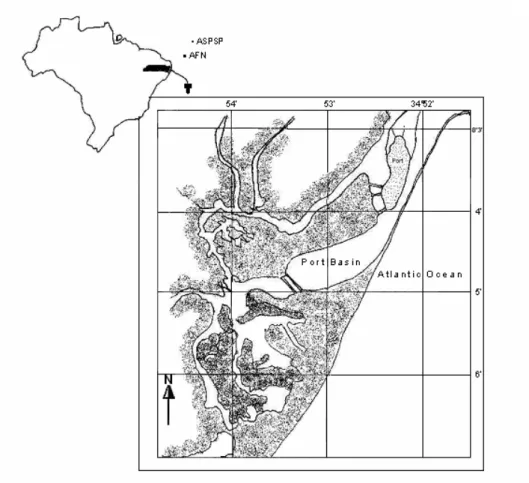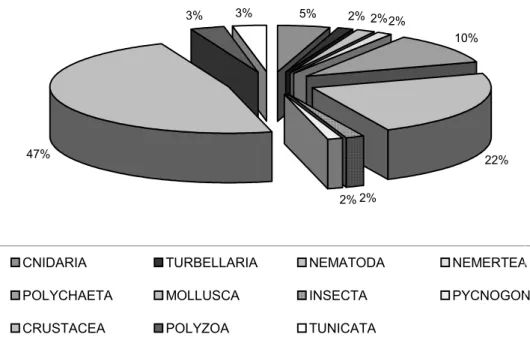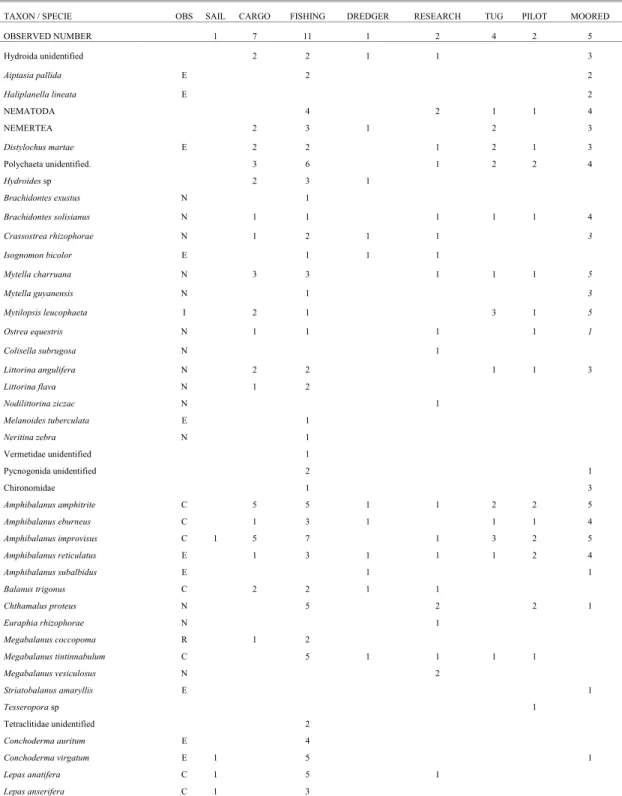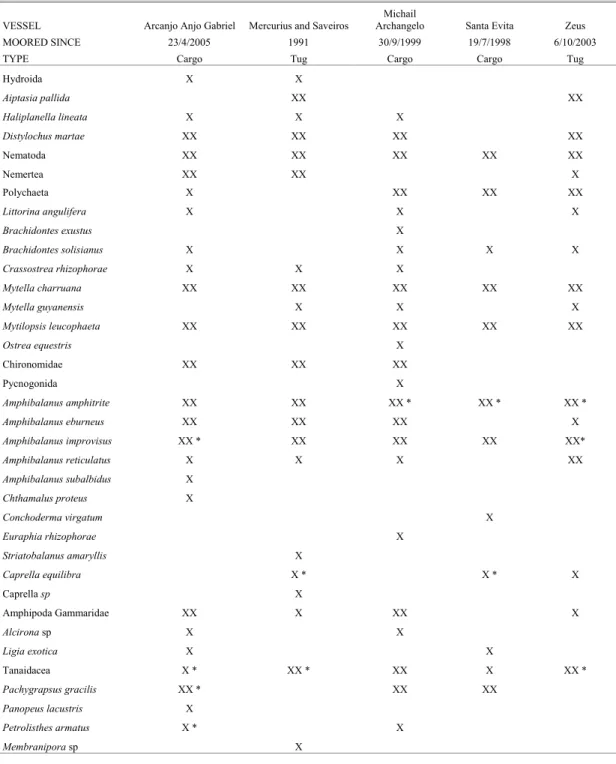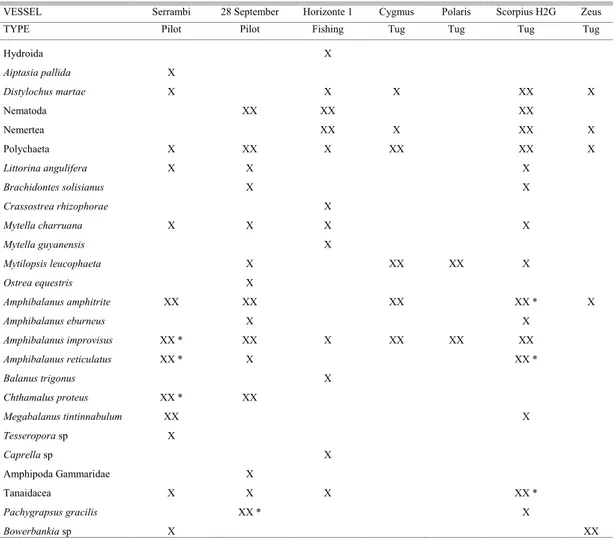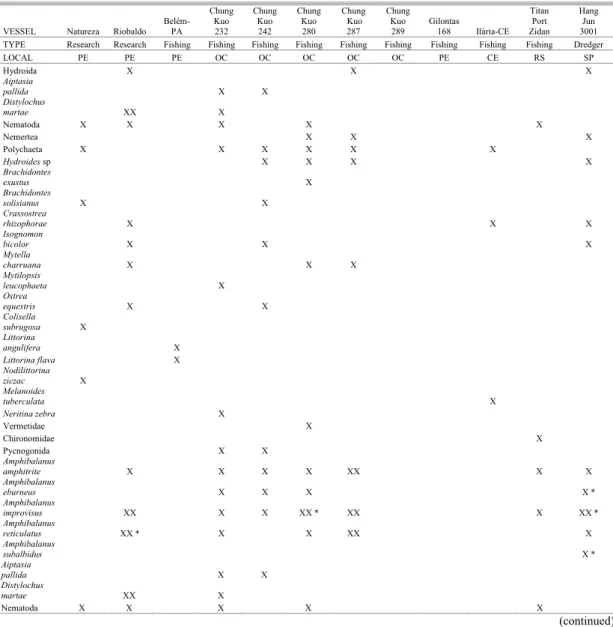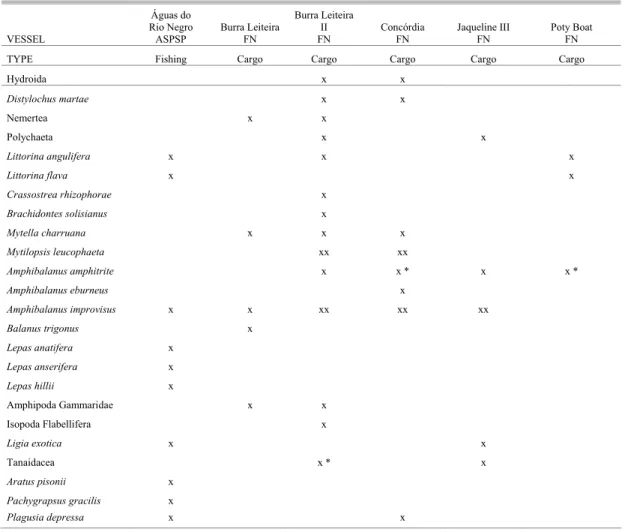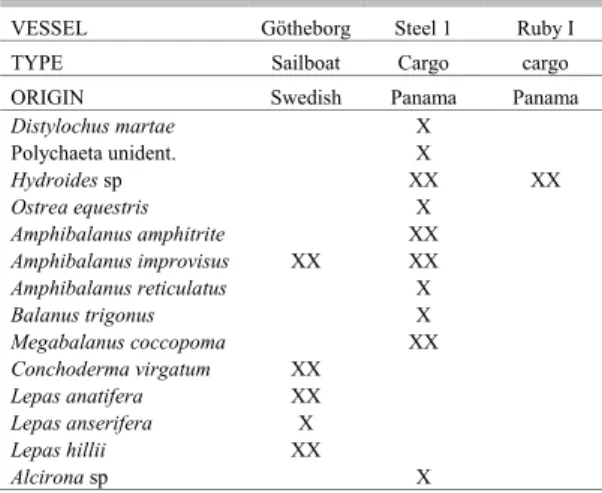BRAZILIAN JOURNAL OF OCEANOGRAPHY, 55(3):207-221, 2007
SHIP HULL FOULING IN THE PORT OF RECIFE, PERNAMBUCO*
Cristiane Maria Rocha Farrapeira¹**, Arthur Vinícius de Oliveira Marrocos de Melo, Débora Ferreira Barbosa& Karla Maria Euzebio da Silva
¹Universidade Federal Rural de Pernambuco – UFRPE Departamento de Biologia
(Rua Dom Manoel de Medeiros, s/nº, Dois Irmãos, 52171-900 Recife, PE, Brasil)
**Corresponding author: c.farrapeira@db.ufrpe.br
A
B S T R A C TPorts of big coastal cities are exposed to exotic species as a consequence of shipping traffic. As the Port of Recife receives an annual average of 491 ships from other regions of Brazil and from all over the world, this work was aimed at knowing which marine animals were passively transported on such vessels hulls, in order to map and monitor new bioinvasions in the area. Thus, 32 vessels of several origins were investigated between November 2005 and March 2006, samples were taken and the macrofauna identified. Sixty species of associated animals were identified, consisting of 28 sessile species, particularly the Cirripedia Balanomorpha and Lepadomorpha as dominants, 8 sedentary animals, namely Mytillidae and Dreissenidae and 23 free-living species, particularly, Caprellidae, Gammaridae, Tanaidacea, Turbellaria, Nemertea and Polychaeta. The first occurrence of Conchoderma virgatum was recorded with exact location for the Brazilian littoral, and Conchoderma auritum, Amphibalanus subalbidus and Haliplanella lineata were recorded for the first time at the littoral of Pernambuco State. The invasion pathway was confirmed for Amphibalanus reticulatus and Mytilopsis leucophaeta, invader species of the estuarine area of Recife’s city. Megabalanus coccopoma was considered as a risk invader species for the region.
R
E S U M ORegiões portuárias das grandes cidades litorâneas estão sujeitas à recepção de espécies exóticas como conseqüência da movimentação dos navios. Como o Porto do Recife recebe uma média anual de 491 atracações de navios, provenientes de várias regiões do Brasil e do mundo, objetivou-se conhecer quais animais marinhos eram transportados passivamente nos cascos das embarcações para mapear e monitorar novas invasões biológicas na área. Assim, foram investigados 32 barcos de diversas origens, nos meses de novembro de 2005 a março de 2006, tendo a macrofauna sido amostrada e identificada. Foram encontradas 60 espécies de animais associados, sendo: 28 espécies incrustantes, destacando-se os Cirripedia Balanomorpha e Lepadomorpha, como dominantes, 8 sedentárias, destacando-se os Mytillidae e Dreissenidae e 23 vágeis, sendo os principais: Caprellidae, Gammaridae, Tanaidacea, Turbellaria, Nemertea e Polychaeta. A primeira citação de Conchoderma virgatum foi registrada com localização exata para o litoral brasileiro, e Conchoderma auritum, Amphibalanus subalbidus e Haliplanella lineata foram registradas pela primeira vez para o litoral do estado de Pernambuco. O meio de dispersão foi confirmado para Amphibalanus reticulatus e Mytilopsis leucophaeta, espécies invasoras da área estuarina da Cidade do Recife. Megabalanus coccopoma foi considerada como espécie em risco de invasão para a região.
Descriptors: Vessels, Hull fouling, Bioinvasion, Biofouling, Barnacles, Port of Recife.
Descritores: Embarcações, Incrustação em cascos de navios, Bioinvasão, Bioincrustação, Cirrípedes, Porto do Recife.
I
NTRODUCTIONFouling is a nautical and industrial term, subsequently adopted by marine ecologists, to refer to marine ecosystems consisting of organisms which attach to (epibionts), bore into (infauna) or otherwise live on hard natural or artificial substrata (Baker et al.,
2004). __________
(*) Paper presented at the 1st Brazilian Congress of Marine Biology, on 15-19 May 2006. Rio de Janeiro, Brazil.
consumption and corrosion (Clarke, 1995; Baker et al., 2004;Floerl, 2005). Invasions by non-indigenous species are a major force of global change, resulting in significant ecological, economic, and human health impacts.
Marine biological invasions brought about by anthropogenic influences have occurred throughout the world through a variety of mechanisms including shipping, aquaculture; live seafood and bait shipments; the activities of commercial, educational and research aquariums; biocontrol and human-created canals (Ruiz
et al., 2000; Godwin, 2003). There are other pathways associated with maritime vessel activity that can be responsible for introductions. Some new arrivals are probably dispersed naturally by oceanic currents carrying larvae or adults, but this mode of dispersal is virtually impossible to confirm (Forster & Willan, 1979).
The ocean-going vessels can be thought of as “biological islands” for species that dwell in harbors and estuaries, since they provide substrate for the settlement of species associated with fouling communities (Godwin, 2003). Fouling on vessel hulls creates entirely new transfer pathways for biological communities across substantial biogeographical barriers, and the dispersal of marine organisms by shipping has long been used in interpreting the biogeography of marine invertebrates, often in retrospect once a foreign species is found established (Foster & Willan, 1979; Carlton & Geller, 1993). In fact, the primary pathway identified for marine non-indigenous organisms introductions has been maritime vessel traffic to ports around the world by the biofouling on ships, but the transport of organisms in ballast water has also been recognized as the major vector for the inadvertent transfer of many shallow water benthic non-indigenous and harmful organisms around the globe (Carlton & Geller, 1993; Ruiz et al., 2000; Godwin & Eldredge, 2001; Gollasch, 2002; Coutts & Taylor, 2004).
When in a new environment, introduced animals can compete with native ones for food or space resulting in high population densities and large body sizes. They can also introduce new pests, parasites, or pathogens, because they may bring with them all or a subset of their native parasite fauna, and microbial infections, and generally cause a disruption to the native environment (DeFelice et al., 2001; Torchin et al., 2001; 2003).
The transport of non-indigenous species by commercial shipping typically results in port environments becoming major points of biotic invasion, with a greater density and diversity of organisms (Wasson et al., 2001; Hewitt et al., 2004). Vessels acquire the majority of hull fouling while moored in coastal ports, these environments acting as hubs of domestic and international shipping
movements (Carlton, 1987). Stationary vessels provide substrate for the settlement of fouling species, including protected recesses that can be occupied by both sessile and mobile fauna (Godwin, 2003).
Pernambuco State lies in the South Atlantic Ocean, in a region of tropical climate. In recent years, there have been occurrences of aquatic invaders, including the false dark mussel Mytilopsis leucophaeta, and the swimming crab Charybdis hellerii, both introductions assumed to be via ships’ ballast water (Souza et al., 2005; Tavares & Mendonça, 1996; Coelho & Santos, 2003), and the barnacles Striatobalanus amaryllis and Amphibalanus reticulatus, assumed to be via hull biofouling.
On the basis of the above considerations, and that the Port of Recife receives ships of many kinds proceeding from other regions of Brazil and other countries of the world, a survey was planned and conducted with the following main objectives of establishing the identity, frequency of occurrence and distribution of the predominant animals’ species associated with the various shipping trade routes, and then to know which ones are carried passively by vessels that arrive in the port in order to map and monitor new biological invasions in the area.
Port of Recife Area
Fig. 1. Location of the Port of Recife and Brazilian archipelagos in the South Atlantic Ocean: AFN= Archipelago Fernando de Noronha, ASPSP= Archipelago São Pedro e São Paulo (Port area scale; 1:25.000).
M
ATERIAL ANDM
ETHODSBetween November 2004 and April 2006, fortnightly samples of fouling organisms were collected from all vessels arriving to the Port of Recife, Pernambuco. Material was scraped by spatula and hammer on the submerged parts and wave-splash zone from as many different areas of the hull as required for a representative sampling, looking for the different morpho-species and collecting them in a plastic bag. Although seaweed had been collected, they had not been object of study of the present research. The animals were fixed in 4% formalin and identified under stereomicroscopy using the pertinent literature. Some organisms could not be identified to species level due to taxonomic difficulties with their groups, and such results are presented at a higher taxon level.
Information on the nature and provenance of the ships and boats was either obtained directly, either
asking the crew members or from the shipping agents that handled each vessel or consulting the daily bulletin board on the website of the Port of Recife (Port of Recife, 2006). During the samplings, salinity was measured by a portable densimeter.
Since it is difficult to make a fully quantitative assessment of the fouling growth on a ship’s hull, a more subjective appraisal of fouling intensity was adopted. Thus, records show firstly the different species found on ships of various types and secondly, the number of these ships on which each species was regarded as an important component of the various fouling assemblages. To monitor these biofouling communities, some boats were investigated several times (mainly vessels coming from the Brazilian archipelagos), but these are only represented once in the Tables. Observations were made on organisms’ reproductive status whenever possible, by considering the gonad development or the presence of incubated eggs or larvae.
In this paper fouling organisms were considered to be any sessile or sedentary species which attach to hard substrates, both natural and man-made. To present the results, the following terms and definitions were used, summarized from Eno et al. (1997) and Clarke et al. (2004):
• Native (N) species with a long natural presence in the region, that may extend into the pre-historic record;
• Cryptogenic (C) species that are neither demonstrably native nor introduced, in other words, their native range is uncertain;
• Exotic (E) species that have been transferred by human activity into a region beyond their natural range or natural zone of potential dispersal;
• Invasive (I) species, an established introduced species that spreads rapidly through a range of natural or semi-natural habitats and ecosystems, mostly by its own means;
• Risk (R) species likely deemed to become harmful if introduced to a region beyond their natural range, as based on inductive evaluation of available evidence.
R
ESULTSIncidence of Fouling Species on Vessels
Fouling organisms were sampled from the hulls of 32 vessels. A total of 60 species were recorded, representing 9 animals phyla: 3 species of Cnidaria (1 hydroid and 2 anemones), 1 Platyhelminthes (flatworm), 1 Nematoda, 1 Nemertea, 7 Annelida (marine worms), 15 Mollusca (3 oysters, 5 mussels, 6 snails and 1 vermetids), 33 Arthropoda (1 Insecta chironomid, 1 Pycnogonida and 31 Crustacea- 19 barnacles, 1 tanaidaces, 3 amphipods, 2 isopods and 6 crabs), 2 Polyzoa (moss animals) and 2 Chordata [subphylum Urochordata] (sea squirts) (Fig. 2).
Eight types of vessels were investigated that were stationary or temporarily moored in the Port of Recife including 12 fishing, 9 cargo, 6 tugboat, 2 research, 2 pilot, 1 dredger and 1 sail ship. Table 1 shows the species or taxa identified, indicating the type of vessels where they were found and the organisms’ status (as native, cryptogenic, exotic, and risk species) with regard to the Port of Recife.
5%
2% 2%2%
10%
22%
2% 2% 47%
3% 3%
CNIDARIA TURBELLARIA NEMATODA NEMERTEA
POLYCHAETA MOLLUSCA INSECTA PYCNOGON
CRUSTACEA POLYZOA TUNICATA
Table 1. Checklist of species sampled on the hulls of eight vessels’ types (sail, cargo, fishing, dredger, research, tugboat, pilot, and moored ship) operating in the Port of Recife, Pernambuco, Brazil. N= native; C=cryptogenic; E= exotic; I= invasive; R= risk (all of them considering the Northeast region of Brazil).
TAXON / SPECIE OBS SAIL CARGO FISHING DREDGER RESEARCH TUG PILOT MOORED OBSERVED NUMBER 1 7 11 1 2 4 2 5
Hydroida unidentified 2 2 1 1 3
Aiptasia pallida E 2 2
Haliplanella lineata E 2
NEMATODA 4 2 1 1 4
NEMERTEA 2 3 1 2 3
Distylochus martae E 2 2 1 2 1 3
Polychaeta unidentified. 3 6 1 2 2 4
Hydroides sp 2 3 1
Brachidontes exustus N 1
Brachidontes solisianus N 1 1 1 1 1 4
Crassostrea rhizophorae N 1 2 1 1 3
Isognomon bicolor E 1 1 1
Mytella charruana N 3 3 1 1 1 5
Mytella guyanensis N 1 3
Mytilopsis leucophaeta I 2 1 3 1 5
Ostrea equestris N 1 1 1 1 1
Colisella subrugosa N 1
Littorina angulifera N 2 2 1 1 3
Littorina flava N 1 2
Nodilittorina ziczac N 1
Melanoides tuberculata E 1
Neritina zebra N 1
Vermetidae unidentified 1
Pycnogonida unidentified 2 1
Chironomidae 1 3
Amphibalanus amphitrite C 5 5 1 1 2 2 5
Amphibalanus eburneus C 1 3 1 1 1 4
Amphibalanus improvisus C 1 5 7 1 3 2 5
Amphibalanus reticulatus E 1 3 1 1 1 2 4
Amphibalanus subalbidus E 1 1
Balanus trigonus C 2 2 1 1
Chthamalus proteus N 5 2 2 1
Euraphia rhizophorae N 1
Megabalanus coccopoma R 1 2
Megabalanus tintinnabulum C 5 1 1 1 1
Megabalanus vesiculosus N 2
Striatobalanus amaryllis E 1
Tesseropora sp 1
Tetraclitidae unidentified 2
Conchoderma auritum E 4
Conchoderma virgatum E 1 5 1
Lepas anatifera C 1 5 1
Lepas anserifera C 1 3
Table 1. (continued)
TAXON / SPECIE OBS SAIL CARGO FISHING DREDGER RESEARCH TUG PILOT MOORED OBSERVED NUMBER 1 7 11 1 2 4 2 5
Lepas hillii C 1 5
Alcirona unidentified 2 2
Ligia exotica N 1 2 1 2
Caprella equilibra C 1 3
Caprella sp 1
Gammaridae unidentified 2 1 1 2 1 4 Tanaidacea unidentified 2 5 1 1 2 5
Aratus pisonii C 1
Pachygrapsus gracilis C 2 1 1 3
Pachygrapsus transversus C 1
Panopeus lacustris N 1
Petrolisthes armatus N 2
Plagusia depressa N 1 1
Bowerbankia sp 3 1 1
Membranipora sp 1 1
Styela plicata E 1 1 1
Ascidian unidentified 1 1
In the sampling period, the salinity of the harbor area varied from 20 at low tide) to 35 at high tide.
Vessels with Long-term Moorings to the Port of Recife Three cargo ships and two tugboats out of commission, anchored in the Port of Recife for more than one year were inspected. They showed the typical fouling community of the estuarine euhaline area of the Port basin, with severe fouling in almost all vessels. Thirty seven species of animals were identified, including the following exotics: the anemone Haliplanella lineata and barnacle
Striatobalanus amaryllis (found only in two of these boats), the flatworm Distylochus martae, the false dark mussel Mytilopsis leucophaeta, and the barnacles
Amphibalanus reticulatus, A. subalbidus and
Conchoderma virgatum (Table 2).
Mussels (Mytella charruana and Mytilopsis leucophaeta) and barnacles (Amphibalanus amphitrite
and A. improvisus) were found on all vessels moored long-term in the Port of Recife and were numerically dominant, with Nematoda and Tanaidacea as accompanied fauna. Considerable mortality of barnacles was evident on the steel substrate of the “Mercurius” and “Saveiros” tugboats, out of service since 1991. Curiously, these tugboats have a band of settlement of Striatobalanus amaryllis (all of them dead) and Amphibalanus reticulatus (the majority dead), with flatworms (Distylochus martae) and Chironomiidae larvae and pupae inside the barnacle shells. These tugboats were sunk in the littoral of
Recife in April 2006, to provide an artificial reef (as fishing attraction).
Somewhat similar results were recorded on the Greek ship originally called “Kings Town” (presently in repair, with the new name “Michail Archangelo”), out-docked since September 1999, that had several indigenous species of the Pernambuco coast, mainly present in the harbor basin and estuarine area of Recife, in the euhaline regions. These included
Amphibalanus amphitrite, A. eburneus, A. improvisus, Mytella charruana and a heavy settlement of the recent introduced and invasive species, Mytilopsis leucophaeta. The same community was observed at the “Zeus” tugboat moored to the Port since October 2003 (which was cleaned in March 2006 and is now operating in the coastal harbor area); the fishing boat “Tontini” (now called “Santa Evita”), moored since July 1999 and the cargo ship “Arcanjo Anjo Gabriel”, from the Fernando de Noronha Archipelago, moored to the port since May 2005.
Vessels Limited to the Neighborhood of the Port of Recife Fouling on seven vessels with their itinerary around the Port of the Recife region including: two pilot boats, one fishing boat and four tugboats were also investigated. Twenty six species of fouling animals were identified, including the following exotics animals: the flatworm Distylochus martae, the false dark mussel Mytilopsis leucophaeta, and the barnacle Amphibalanus reticulatus. The barnacle A. improvisus was numerically dominant and present on all boats. A noteworthy finding was a species of
Table 2. Checklist of fouling species observed on the hulls of five vessels moored long-term in the Port of Recife, Pernambuco, Brazil. X = present; XX = numerically dominant on the vessel’s hull; * in reproduction.
VESSEL Arcanjo Anjo Gabriel Mercurius and Saveiros
Michail
Archangelo Santa Evita Zeus
MOORED SINCE 23/4/2005 1991 30/9/1999 19/7/1998 6/10/2003
TYPE Cargo Tug Cargo Cargo Tug
Hydroida X X
Aiptasia pallida XX XX
Haliplanella lineata X X X
Distylochus martae XX XX XX XX
Nematoda XX XX XX XX XX
Nemertea XX XX X
Polychaeta X XX XX XX
Littorina angulifera X X X
Brachidontes exustus X
Brachidontes solisianus X X X X
Crassostrea rhizophorae X X X
Mytella charruana XX XX XX XX XX
Mytella guyanensis X X X
Mytilopsis leucophaeta XX XX XX XX XX
Ostrea equestris X
Chironomidae XX XX XX
Pycnogonida X
Amphibalanus amphitrite XX XX XX * XX * XX *
Amphibalanus eburneus XX XX XX X
Amphibalanus improvisus XX * XX XX XX XX*
Amphibalanus reticulatus X X X XX
Amphibalanus subalbidus X
Chthamalus proteus X
Conchoderma virgatum X
Euraphia rhizophorae X
Striatobalanus amaryllis X
Caprella equilibra X * X * X
Caprella sp X
Amphipoda Gammaridae XX X XX X
Alcirona sp X X
Ligia exotica X X
Tanaidacea X * XX * XX X XX *
Pachygrapsus gracilis XX * XX XX
Panopeus lacustris X
Petrolisthes armatus X * X
Membranipora sp X
Table 3. Checklist of fouling species observed on the hulls of six vessels operating in the Port of Recife area, Pernambuco, Brazil. X= present; XX= observed as numerically dominant on the vessel’s hull; *= in reproduction.
VESSEL Serrambi 28 September Horizonte 1 Cygmus Polaris Scorpius H2G Zeus
TYPE Pilot Pilot Fishing Tug Tug Tug Tug
Hydroida X
Aiptasia pallida X
Distylochus martae X X X XX X
Nematoda XX XX XX
Nemertea XX X XX X
Polychaeta X XX X XX XX X
Littorina angulifera X X X
Brachidontes solisianus X X
Crassostrea rhizophorae X
Mytella charruana X X X X
Mytella guyanensis X
Mytilopsis leucophaeta X XX XX X
Ostrea equestris X
Amphibalanus amphitrite XX XX XX XX * X
Amphibalanus eburneus X X
Amphibalanus improvisus XX * XX X XX XX XX
Amphibalanus reticulatus XX * X XX *
Balanus trigonus X
Chthamalus proteus XX * XX
Megabalanus tintinnabulum XX X
Tesseropora sp X
Caprella sp X
Amphipoda Gammaridae X
Tanaidacea X X X XX *
Pachygrapsus gracilis XX * X
Bowerbankia sp X XX
As a general rule, these boats have several native species of the Pernambuco coast, present in the harbor basin and estuarine area of Recife and in the neighboring coastal reefs. The “Horizonte 1” fishing boat that had spent three months in the port after leaving the shipyard is an example of this. The “Zeus” tugboat moored in the Port since October 2003 and cleaned in March, showed several seaweeds with associated nemerteans, marine worms and
Bowerbankia sp moss animals, after one month in operation in the harbor area.
Brazilian Coastal Vessels
This category includes 12 examined vessels that had been operating exclusively on the coastal trade, consisting of 2 research vessels, 1 dredger and 9 fishing boats. The fouling assemblages contained a
total of 51 species, of which 18 species of Cirripedia, the most diverse taxa among the fouling species.
Amphibalanus amphitrite, A. improvisus, Megabalanus tintinnabulum, Chthamalus proteus and
Conchoderma virgatum were the dominant ones. Nine species, or 17.6% of the total community, are known to be invasive in some portion of their range and one,
M. coccopoma, is considered a risk species (Table 4). Several species were at a reproductive stage, a fact observed mainly among the crustaceans.
the intertidal region of Brazilian littoral; the “Riobaldo” vessel showed the richest fouling community seen in this survey, with 24 species, in spite of belonging to the Environmental Ministry. An unidentified barnacle Tesseropora sp was also found on both research boats.
This category of vessels included five fishing boats called “Chung Kuo” (numbers 232, 242, 280, 287, and 289). Originally from Panama, Philippines and China (all the crews from Philippines),
they have operated in the oceanic region of Brazil for seven months, according to the shipping agents that handled those vessels, between the Pernambuco and Pará States, Northeast and Northern regions of Brazil, respectively. This group of vessels showed the second richest fouling community, with 18 - 22 kinds of animals settled on each one, including a Tetraclitidae barnacle, found on the hull of two boats, settled in the crevice of the motor refrigeration water exit.
Table 4. Checklist of fouling species observed on the hulls of six vessels operating in the Brazilian coast. X = present, XX = numerically dominant on the vessel’s hull; * in reproduction; Locals: CE= Ceará; PB= Paraíba; PE= Pernambuco; RS= Rio Grande do Sul; SP= São Paulo States and OC= oceanic (North and Northeast Brazilian littoral).
Aiptasia
pallida X X
Distylochus
martae XX X
Nematoda X X X X X
(continued)
VESSEL Natureza Riobaldo
Belém-PA
Chung Kuo 232
Chung Kuo 242
Chung Kuo 280
Chung Kuo 287
Chung Kuo 289
Gilontas
168 Ilária-CE Titan
Port Zidan
Hang Jun 3001 TYPE Research Research Fishing Fishing Fishing Fishing Fishing Fishing Fishing Fishing Fishing Dredger LOCAL PE PE PE OC OC OC OC OC PE CE RS SP Hydroida X X X
Aiptasia
pallida X X
Distylochus
martae XX X
Nematoda X X X X X
Nemertea X X X
Polychaeta X X X X X X
Hydroides sp X X X X
Brachidontes
exustus X
Brachidontes
solisianus X X
Crassostrea
rhizophorae X X X
Isognomon
bicolor X X X
Mytella
charruana X X X
Mytilopsis
leucophaeta X
Ostrea
equestris X X
Colisella
subrugosa X
Littorina
angulifera X
Littorina flava X
Nodilittorina
ziczac X
Melanoides
tuberculata X
Neritina zebra X
Vermetidae X
Chironomidae X
Pycnogonida X X
Amphibalanus
amphitrite X X X X XX X X
Amphibalanus
eburneus X X X X *
Amphibalanus
improvisus XX X X XX * XX X XX *
Amphibalanus
reticulatus XX * X X XX X
Amphibalanus
subalbidus X *
Table 4. (continued)
VESSEL Natureza Riobaldo
Belém-PA
Chung Kuo 232
Chung Kuo 242
Chung Kuo 280
Chung Kuo 287
Chung Kuo 289
Gilontas
168 Ilária-CE Titan
Port Zidan
Hang Jun 3001 TYPE Research Research Fishing Fishing Fishing Fishing Fishing Fishing Fishing Fishing Fishing Dredger LOCAL PE PE PE OC OC OC OC OC PE CE RS SP
Hydroida X X X
Nemertea X X X
Polychaeta X X X X X X
Hydroides sp X X X X
Brachidontes
exustus X
Brachidontes
solisianus X X
Crassostrea
rhizophorae X X X
Isognomon
bicolor X X X
Mytella
charruana X X X
Mytilopsis
leucophaeta X
Ostrea
equestris X X
Colisella
subrugosa X
Littorina
angulifera X
Littorina
flava X
Nodilittorina
ziczac X
Melanoides
tuberculata X
Neritina
zebra X
Vermetidae X
Chironomidae X
Pycnogonida X X
Amphibalanus
amphitrite X X X X XX X X
Amphibalanus
eburneus X X X X *
Amphibalanus
improvisus XX X X XX * XX X XX *
Amphibalanus
reticulatus XX * X X XX X
Amphibalanus
subalbidus X *
The Lepadomorpha barnacles, mainly Lepas anatifera and L. hillii, were common on almost all fishing boats, including the “Titan - Port Zidan”, from Rio Grande do Sul, in the extreme Southern region of Brazil, which also carried dead specimens of
Megabalanus coccopoma.
The “Hang Jun 3001” dredger vessel that came from Santos (São Paulo State- Southwest region of Brazil) and which dredged muddy sediments at the Port of Recife for three months (October to December 2005), brought several species on its hull, including the barnacle Amphibalanus subalbidus (in reproduction - with eggs incubated in the mantle cavity) and the purse-oyster Isognomon bicolor.
Vessels Navigating Between Recife and the Atlantic Brazilian Archipelagos
Several inspections were made on five cargo vessels and 1 fishing boat operating between the Port of Recife and the archipelagos of Fernando de
Noronha (Pernambuco) and São Pedro e São Paulo, both in the Atlantic Ocean (Table 5). Some mollusks (especially Brachidontes solisianus, Mytilopsis leucophaeta, Littorina angulifera and L. flava) and barnacles (mainly Amphibalanus amphitrite, A. eburneus, A. improvisus, and A. reticulatus), belong to the estuarine community of the harbor area; the lepadomorphs Conchoderma auritum, C. virgatum, Lepas anatifera, L. anserifera and L. hillii are considered typically oceanic.
isolated group of barren islets (0º55’N, 29º21’W), approximately 960 km from the Cabo de São Roque, Rio Grande do Norte, in the northeast coast of Brazil, and 650 km from the southwest of the Fernando de Noronha Archipelago (Edwards & Lubbock, 1983), is maintained by the Brazilian Navy. Both these archipelagos are formed by the mountain peaks of a volcanic cordillera, with its base located about 4,000 m deep, part of the mid-Atlantic ridge.
Nineteen fouling species were found on the five Fernando de Noronha Archipelago cargo boats that stayed at the Port of Recife for approximately 3
days. On two vessels (“Concórdia” and “Burra Leiteira II”), several barnacles specimens (Amphibalanus amphitrite) and Tanaidacea were found in reproduction (with incubated eggs).
From the Archipelago São Pedro e São Paulo, only the “Águas do Rio Negro” fishing boat was investigate. This boat stayed there 30 - 45 days, and in the Port of Recife 4 - 6 days. Ten animals were sampled from this boat, including the grapsid crab
Plagusia depressa (2-3 specimens, all young, in all samples) and the lepadomorph barnacles.
Table 5.Checklist of fouling species observed on the hulls of six vessels operating in the Brazilian Archipelagos of Fernando de Noronha (FN) and São Pedro e São Paulo (ASPSP). X = present, XX = numerically dominant on the vessel’s hull.
VESSEL
Águas do Rio Negro ASPSP
Burra Leiteira FN
Burra Leiteira II FN
Concórdia FN
Jaqueline III FN
Poty Boat FN
TYPE Fishing Cargo Cargo Cargo Cargo Cargo
Hydroida x x
Distylochus martae x x
Nemertea x x
Polychaeta x x
Littorina angulifera x x x
Littorina flava x x
Crassostrea rhizophorae x
Brachidontes solisianus x
Mytella charruana x x x
Mytilopsis leucophaeta xx xx
Amphibalanus amphitrite x x * x x *
Amphibalanus eburneus x
Amphibalanus improvisus x x xx xx xx
Balanus trigonus x
Lepas anatifera x
Lepas anserifera x
Lepas hillii x
Amphipoda Gammaridae x x
Isopoda Flabellifera x
Ligia exotica x x
Tanaidacea x * x
Aratus pisonii x
Pachygrapsus gracilis x
Plagusia depressa x x
Foreign Routes/shipping
These analyses included the international voyages (between countries and oceans) with animals belonging to fourteen species. Heavy fouling of
Hydroides sp was observed on two cargo ships from Panama, and a sail ship from temperate North Atlantic was marked by the presence of lepadomorph barnacles and one species of acorn barnacle(Table 6).
Table 6.Checklist of fouling species observed on the hulls of three vessels operating internationally. X = present, XX = observed as numerically dominant on the vessel’s hull.
VESSEL Götheborg Steel 1 Ruby I
TYPE Sailboat Cargo cargo
ORIGIN Swedish Panama Panama
Distylochus martae X
Polychaeta unident. X
Hydroides sp XX XX
Ostrea equestris X
Amphibalanus amphitrite XX
Amphibalanus improvisus XX XX
Amphibalanus reticulatus X
Balanus trigonus X
Megabalanus coccopoma XX
Conchoderma virgatum XX
Lepas anatifera XX
Lepas anserifera X
Lepas hillii XX
Alcirona sp X
This category included the Swedish sailing ship “Götheborg”, that had departed from the city of Götheborg on 2 October 2005, routing to Spain through the Channel, with a stop in Vigo of about 30 days, and then mooring in Cádiz, with 12 days stop. From Spain, this ship sailed south and then west crossing the Atlantic and passing the Equator to Recife, in Brazil. The trans-Atlantic part of the route took about 30 days. This ship brought only lepadomorph barnacles: Conchoderma virgatum, Lepas anatifera, L. anserifera, L. hillii and several recently-recruited Amphibalanus improvisus in the seaweed and settled on barnacle shells and stalk. None of the stalked barnacles examined had any sign of ovaries or ovigerous lamellae.
The “Ruby” cargo ship showed a fouling community dominated only by the annelid Hydroides
sp, with about 2 m of vertical range. A similar situation was seen on the “Steel 1” cargo ship, although other organisms were also found, mainly in the poop, near the screw propeller. These included the barnacles Amphibalanus improvisus and dead specimens of Megabalanus coccopoma.
D
ISCUSSIONNon-indigenous marine species have been transported and introduced into new areas for as long
as vessels with fouling organisms in their hulls have sailed between oceans (Coles et al., 1999). Skerman (1960) in his survey of marine fouling from vessels operating on a variety of routes in New Zealand waters, found several fouling species associated with vessels, showing the origin of ship-fouling as a port phenomenon, and with its regional interpretation based on the major trade routes. Since then several authors have surveyed the fouling communities associated with vessel’s hulls with the aim of identifying non-indigenous species and monitoring their bioinvasion, (Coutts & Taylor, 2005; Godwin, 2005). The amount of trans-oceanic shipping has increased greatly, and a tendency of modern vessels to move faster through the water may affect the survival and transport of fouling species and clinging requiring certain characteristics of the species. Furthermore, it may be considered that those species preferentially distributed on ships' hulls have had ample opportunity to spread, especially as some are now cosmopolitan in occurrence (Eno et al., 1997).
It was surprising to find sixty fouling species on vessels in the Port of Recife in spite of the advice control of International Maritime Organization (IMO) and the very wide use of anti-fouling techniques, including paints. The predominance of arthropods in the fouling community sampled here (including crustaceans 47% of the species and insect chironomids and pycnogonids, both representing 2%) was also observed by Ray (2005), who observed respectively 27%, 20% and 6% for these taxa. Also Godwin (2003) observed that 35% of the hulls fouling species invaders to the Hawaiian isles were arthropods, against 16% and 13% of mollusks and polychaetes, respectively. The variety of animals sampled in this survey were similar in composition to the checklist of several authors, varying sometimes the species (but not the genus), except for the cosmopolitan species, mainly pan-tropical ones.
The Cirripedia, with nineteen species (fourteen acorn and five stalked barnacles) were the most diverse taxa among the fouling species. This group is also the most representative in almost all works elsewhere. Sampling on the 'Maui' oil platform, Forster & Willan (1979) found twelve species of barnacles, eight balanomorphs and four lepadomorphs; these last ones represented by Conchoderma and
Lepas genera, which are truly cosmopolitan andmay breed and settle in particular water masses and be transported beyond favorable regions.
(1987) showed that the coastal ports and marinas act as hubs of domestic and international shipping movements. Floerl (2005) complemented this understanding saying that both the physical structure and the geographic location of port environments can influence fouling on the hulls of residence ships. As a result of the human-mediated introductions, the fauna of many harbor areas has become homogenized as native species are reduced in abundance and habitat breadth (Ruiz et al., 1997).
The finding that the pilot boats, tugboats and fishing boats limited to the neighborhood of the Port of Recife showed the same composition of the port is explained by Godwin (2003) who signalized that slow moving vessels that have long residence times in port and the vessels from decommission yards are more likely to develop fouling organisms than those that have short residence times and are transiting more often. It is a general experience that the prolonged immersion in the sea of a suitable substratum ultimately results in the development of a fouling assemblage, the structure of which is to some extent reproducible, stable, and characteristic of the locality observed (Skerman, 1960).
In relation of the vessels that navigate exclusively on the coastal trade, the fouling community can be separated in two types: the dredger community and that one settled on fishing and research boats. The dredger sampled in this last category showed high species diversity, mainly originally from the port area and coastal reefs of the Brazilian littoral, three of the species in reproduction stage. This result is different from that of Skerman (1960), who found that fouling from dredgers is not considered to be truly representative of the home port, since the silt-laden waters around an operating dredger probably impose some degree of selection on the survival of attached fouling organisms. The others boats of this category presented the richest number of species predominantly barnacles (eighteen species), several of them in reproduction. Baker et al. (2004) made similar observations based on the high numbers of private yachts and fishing vessels of the greater Tampa Bay area. Hull maintenance of yachts and fishing vessels is variable, records are spotty, regulations are non-existent, and movements by these vessels have been implicated in the intra-coastal spread of non-indigenous species. Typical groups of organisms, with many of the above-mentioned properties, did tend to develop upon vessels in the category under consideration as a result of complete or partial immobility or extended out-of-dock periods (Woods Hole Oceanographic Institution, 1952).
Higher vessel speeds, which sweep away most attached organisms, and antifouling paints have reduced hull fouling on major commercial vessels. Whilst as observed in this survey fouling can still
occur on such vessels, in areas that lack antifouling paint or that are not swept directly by currents (Coutts & Taylor, 2004). Hull fouling is now generally more important for other types of vessels. For example, oceanic barges move slowly, seldom have their hulls serviced, and spend weeks to months in each harbor. A single modern barge can have as much surface area as a fleet of 17th century galleons, and may support a dense and varied fouling community (Godwin & Eldredge, 2001).
The presence of Striatobalanus amaryllis
and Amphibalanus reticulatus on the hulls of tugboats out-docked since the decade of 1990 suggests ship-borne introductions and appears to corroborate the arrival of these species at Pernambuco littoral in the Nineties, as pointed out by for that state. These species are considered as invaders, with potential to colonize new environments; S. amaryllis has been in the Brazilian littoral for at least 17 years (Neves & Rocha, 2005), being found now amongst the species colonizing the Paranaguá Bay, in southern Brazil, as a result of intermediation of recreational vessels.
The species Amphibalanus subalbidus is currently found on most available substrata in brackish environments along the east coast of the United States, Trinidad, Gulf of Mexico, and in the northern Gulf of California region, indicating a naturally derived amphi-American distribution since the Mio-Pliocene (Van Syoc, 1992). Young (1994) found this species at Paraíba State (northeastern Brazil) and the arrival to the littoral of Pernambuco, a neighboring state, may have occurred through biofouling on fishing boats.
Another species that offers risk of bioinvasion in the northeast littoral of Brazil is
Megabalanus coccopoma, found in two vessels that came to the Port of Recife, one from Panama, the other from Rio Grande do Sul (southern Brazil). This species is considered a nuisance fouler in Brazilian ports near and northward from Rio de Janeiro (Russell
et al., 2004), where it may out-compete with the native congeneric, M. tintinnabulum, becoming dominant there (Young, 1994).
Finally, the number species associated to hulls of vessels that navigate between the Port of Recife and the Brazilian archipelagos is noteworthy, some of them well developed and at reproductive stage, which had never been cited as typical species from there.
This research showed that eleven taxa are involved in ship hull fouling in the Port of Recife comprising 28 sessile species, 8 sedentaries, and 23 free-living. The first observation of Conchoderma virgatum with exact location to the Brazilian littoral was recorded, and the first occurrence of
Conchoderma auritum, Amphibalanus subalbidus and
State. In relation to the species already recorded for the estuarine area of Recife, it was confirmed that ship hull provided the pathway for the introduction of
Amphibalanus reticulatus and Mytilopsis leucophaeta, invader species of the estuarine area of Recife City.
The barnacle Megabalanus coccopoma was observed dead on two vessels and was considered to be a potential risk invader species for the region.
R
EFERENCESBAKER, P.; BAKER, S. M.; FAJANS, J. Nonindigenous marine species in the greater Tampa Bay ecosystem.
Tampa Bay Estuary Program Tech. Publ., n. 02-04,
2004.
BOULTON, L. H.; POWELL, C. A.; HUDSON, W. B. Aspects of biofouling and corrosion on ship hulls clad with copper-nickel. In: ANNUAL CONFERENCE OF THE AUSTRALASIAN CORROSION ASSOCIATION, CORROSION AND PREVENTION 99, 1999, Sydney. Proceedings…. Sydney: the Australasian Corrosion Association., 1999. p 1-9. CARLTON, J. T. Patterns of transoceanic marine biological
invasions in the Pacific Ocean. Bull. Mar. Sci., v. 41, p. 452-465, 1987.
CARLTON, J. T.; GELLER, J. B. Ecological roulette: biological invasions and the global transport of non-indigenous marine organisms. Science, v. 261, p. 78-82, 1993.
CLARKE, A. Natural ways to banish barnacles. New Scient., v. 18, p. 38-41, 1995.
CLARKE, C. et al.Ballast water risk assessment, Port of
Sepetiba, Federal Republic of Brazil. London: IMO,
2004. 99 p.
COELHO, P. A.; SANTOS, M. C. F. Ocorrência de Charybdis hellerii (Milne Edwards, 1867) (Crustacea, Decapoda, Portunidae) no litoral de Pernambuco. Bolm
Téc.-Cient. CEPENE, v. 11, n. 1, p. 167-173, 2003.
COLES, S. L.; DEFELICE, R. C.; ELDREDGE, L. G. Nonindigenous marine species introductions in the harbors of the South and West shores of Oahu, Hawaii.
Bishop Mus. Tech. Rep., v. 15, p. 1-228, 1999.
COUTTS, A. D. M.; TAYLOR, M. D. A preliminary investigation of biosecurity risks associated with biofouling on merchant vessels in New Zealand. New
Zealand J. Mar. Freshw. Res., v. 38, n. 2, p. 215-229,
2004.
COUTTS, A. D. M.; TAYLOR, M. D. Biofouling on merchant vessels in New Zealand. In: GODWIN, L. S.
ed. Hull fouling as a mechanism for marine invasive
species introductions. Bishop Mus. Tech. Rep., 28:
14-21. 2005.
DEFELICE, R. C.; ELDREDGE, L. G.; CARLTON, J. T. Nonindigenous invertebrates. In: ELDREDGE, L. G.; SMITH, C. M. A guidebook of introduced marine
species in Hawaii. Bishop Mus. Tech. Rep., 21:70 p.
2001.
EDWARDS, A.; LUBBOCK, R. Marine zoogeography of Saint Paul`s Rocks. J. Biogeogr., v. 10, n. 65-72, 1983. ENO, N. C.; CLARK, R. A.; SANDERSON, W. G. (Ed.).
Non-native marine species in British waters: a review
and directory. Peterborough: Joint Nature Conservation Committee, 1997. 136 p.
FLOERL, O. Factors that influence hull fouling on ocean-going vessels. In: Godwin, L. S. ed. Hull fouling as a
mechanism for marine invasive species introductions.
Bishop Mus. Tech. Rep., 28:6-13. 2005.
FOSTER, B. A.; WILLAN, R. C. Foreign barnacles transported to New Zealand on an oil platform. New
Zealand J. Mar. Fresh. Res., v. 13, n. 1, p. 143-149,
1979.
GODWIN, L. S. Hull fouling of maritime vessels as a pathway for marine species invasions to the Hawaiian Islands. Biofouling, v. 19, p. 123-131, 2003. Supplement.
GODWIN, L. S. Maritime activities as a mechanism for introducing marine alien species: issues and management. IN: GODWIN, L. S. (Ed.) Hull fouling as a mechanism for marine invasive species
introductions. Bishop Mus. Tech. Rep., 28:1-5. 2005.
GODWIN, L. S.; ELDREDGE, L. G. 2001. South Oahu marine invasions shipping study. Honolulu: Bishop Mus. Tech. Rep., 20:43 p.
GOLLASCH, S. The importance of ship hull fouling as a vector of species introductions into the North Sea. Biofouling, v. 18, n. 2, p. 105-121, 2002.
HEWITT, C. L. et al. Introduced and cryptogenic species in Port Phillip Bay, Victoria, Australia. Mar. Biol., v. 144, p. 183-202, 2004.
NEVES, C. S.; ROCHA, R. M. Bioinvasão mediada por embarcações de recreio na Baía de Paranaguá, PR e suas implicações para conservação. In: SIMPÓSIO BRASILEIRO SOBRE ESPÉCIES EXÓTICAS INVASORAS, 1., 2005, Brasília. Anais.... Brasília: MMA, IBAMA, 2005. v. 1.
PORT OF RECIFE. Informativos estatísticos. Recife, Agência Nacional de Transportes Aquaviários. Disponível em: <http://www.portodorecife.pe.gov.br>. Acesso em: 13 May 2006. 2006.
RAY, G. L. Invasive estuarine and marine animals of the South Atlantic and Puerto Rico. ANSRP, Tech. Notes, v. 5, n. 5, p. 1-14, 2005.
RUIZ, G. M. et al. Global invasions of marine and estuarine habitats by non-indigenous species: mechanisms, extent, and consequences. Am. Zool., v. 37, p. 621-632, 1997. RUIZ, G. M. et al. Global spread of microorganisms by ships.
Nature, v. 408, p. 49-50, 2000.
RUSSEL, B. C.; NEIL, K.; HILLIARD, R. Ashmore Reef National Nature Reserve and Cartier Island Marine Reserve marine and terrestrial introduced species
prevention and management strategy. Canberra:
Department of Environment and Heritage, 2004. 18 p. SKERMAN, T. M. Ship-fouling in New Zealand Waters: A
survey of marine fouling organisms from vessels of the coastal and overseas trades. N. Z. Jl. Sci., v. 3, n. 4, p. 620-648, 1960.
SOUZA, J. R. B.; ROCHA, C. M. C.; LIMA, M. P. R. Ocorrência do bivalve exótico Mytilopsis leucophaeta (Conrad) (Mollusca, Bivalvia), no Brasil. Rev. Bras. Zool., v. 22, n. 4, p. 1204-1206, 2005.
TAVARES, M.; MENDONÇA JR, J. B. Charybdis hellerii (A. Milne-Edwards, 1867) (Brachyura, Portunidae), eighth nonindigenous marine decapod recorded from Brazil. Crustacean Res., v. 25, p. 151-157, 1996. TORCHIN, M. E.; LAFFERTY, K. D.; KURIS, A. M.
performance of a globally introduced marine crab. Biol.
Invasions, v. 3, p. 333–345, 2001.
TORCHIN, M. E. et al. Introduced marine species and their missing parasites. Nature, v. 421, p. 628-630, 2003. VAN SYOC, R. I. Living and fossil populations of a Western
Atlantic barnacle, Balanus subalbidus Henry, 1974, in the Gulf of California region. Proc. San Diego Soc. Natl. Hist, n. 12, p. 1-7, 1992.
WASSON, K. et al. Biological invasions of estuaries without international shipping: the importance of intraregional transport. Biol. Conserv., v. 102, n. 2, p. 143–153, 2001.
WOODS HOLE OCEANOGRAPHIC INSTITUTION.
Marine fouling and its prevention. Annapolis: United
States Naval Institute, 1952. 338 p.
YOUNG, P. S. The Balanoidea (Cirripedia) from the Brazilian coast. Bolm. Mus. Nac., série Zoologia, v. 356, p. 1-36, 1994.
